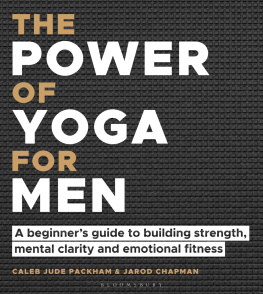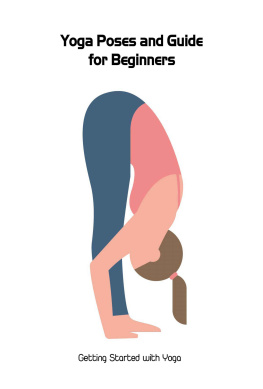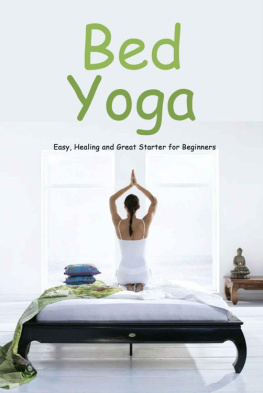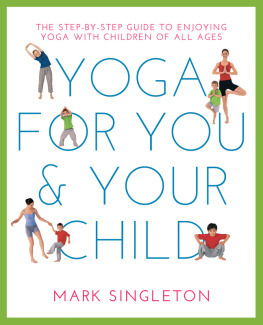
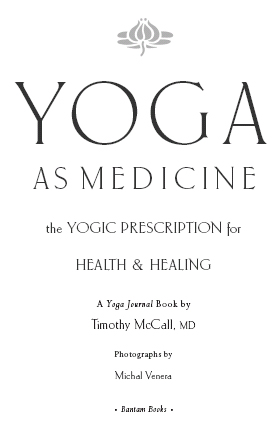
CONTENTS

For my mother,
Mary Elizabeth (Betty) McCall,
who didnt get to name me
but who named this book
Words fail to convey the total value of yoga.
It has to be experienced.
B. K. S. IYENGAR
The book contains general information about the healing potential of yoga and is for informational purposes only. As each individual situation is unique, you should use proper discretion, in consultation with a health care practitioner, before undertaking any of the exercises and techniques described in this book. The author and publisher expressly disclaim responsibility for any adverse effects that may result from the use or application of the information contained in this book.
HOW TO USE THIS BOOK

THIS BOOK IS DIVIDED INTO THREE PARTS. The four chapters that make up part 1 provide an overview of yoga as medicine, the science behind it, the relationship of stress to health and healing, and a yogic approach to health care. Reading chapter 2, on the science of yoga, is not essential to getting the full benefit of this book. But for those who are skeptical or intellectually curious, chapter 2s reviews of the scientific studies that investigate yogas healing powers will be of interest. That chapter also provides possible explanations for yogas benefits that are compatible with Western science, and discusses how science and yoga provide complementary perspectives.
Part 2 contains material that many readers will find useful. Most would benefit from reading chapter 5, Doing Yoga Safely. Readers wanting more information on this topic, including more details on anatomy, should look at appendix 1, Avoiding Common Yoga Injuries. Chapter 6 compares different systems of yoga and provides guidelines on finding a good teacher. Chapter 7 details a step-by-step plan for starting and maintaining a yoga practice.
Part 1 of the book also contains a number of Experiential Exercises, in which you can try specific yoga practices and judge the effects for yourself. Youll get much more out of the book if you do these exercises as you read, especially if youre new to yoga. Yoga is more about practice than theory. To understand it, you must do it, and these exercises provide a gentleyet quite palpableintroduction to the effects of yoga on the body and mind.
Part 3 of the book contains twenty chapters on specific health conditions and concerns, from anxiety to weight loss. Although you may be tempted to go directly to the chapter or chapters that describe conditions you are dealing with, this material will have more meaning to you if youve read all or most of parts 1 and 2. For each of the chapters in part 3, a seasoned yoga teacher describes his or her approach with a specific student who had the condition in question. If you follow yoga, you may recognize many of these teachers as some of yogas leading lights in the United States. Ive chosen a few, however, who are not household names, even in the yoga world. I think youll find they, too, have very interesting things to say.
Keep in mind that many of the experts could have just as easily been the authority for another condition. For example, just because Shanti Shanti Kaur Khalsa, a teacher in the Kundalini yoga tradition, is the consultant for HIV and AIDS does not imply that her approach is the best for this condition, or that Kundalini yoga might work less well for a different problem. I simply hope to show you over the course of these twenty chapters how some of the top teachers from different traditions work. So even if you dont have chronic fatigue syndrome (CFS), you may be interested in the Viniyoga approach taken by Gary Kraftsow in chapter 14. If you want to know about the traditional Indian medical system of Ayurveda, you might look at Sandra Summerfield Kozaks approach to diabetes in chapter 16.
Keep in mind that the chapters in part 3 are descriptive, not prescriptive. Judith Hanson Lasater, for example, outlines in the back pain chapter the approach she took with one student who had sciatica and describes why she recommended what she did. This is not necessarily what she would recommend for another student with back pain, and might be quite different from what another teacher might have suggested for the same student. Still, with these caveats in mind, I believe anyone with back pain will find helpful information in the chapter.
You may also benefit from looking at chapters in part 3 that discuss conditions other than your major concern. Depression, for example, can affect your recovery from many conditions, from heart disease to cancer, so many readers will benefit from reading chapter 15. People with fibromyalgia syndrome or CFS may want to read the chapter on insomnia, since poor sleep is often a prominent component of those conditions. People with diabetes, especially the more common adult onset variety (type 2), may want to look at the chapter on weight loss, since overweight plays a big role in that disease.
In addition to the perspectives of the yoga teacher consultants, in each chapter of part 3 Ill provide an overview of the condition in question from my perspective as a Western-trained doctor; discuss how yoga could fit into treatment; talk about special considerations and contraindications; and try to provide a broader holistic approach to the problem. These chapters also include additional ideas from other yoga experts.
I dont want to overwhelm you with Sanskrit, the ancient language of yoga, so I wont be using that many Sanskrit words in this book. Except for a few indispensable words like asana (the poses) and pranayama (the breathing techniques), when I use Sanskrit Ill usually provide the English translation. When describing some yoga poses and other techniques Ill use a combination of English and Sanskrit names, which is what most yoga teachers do. Youll also find a glossary at the end of the book that defines most of the Sanskrit words used in the book, and another on the Sanskrit words used to name the various poses.
Readers looking for more information on the teachers and systems of yoga discussed in the book can turn to appendix 2, Sources of Further Information. Appendix 3 includes notes and the references for many of the studies cited in the book. The afterword discusses the future of the evolving field of yoga as medicine.
All of the case histories in the book are true. Some students allowed me to use their real names; where indicated, I have changed the students names, if they requested it or I didnt personally interview the student. In those instances some identifying characteristics were also altered to protect confidentiality. One case, in the chapter on chronic fatigue syndrome, is a composite of several students.
INTRODUCTION: A LEAP OF FAITH

IN THIS BOOK, IM ASKING YOU TO THINK OF YOGA AS MEDICINEa concept which is perhaps new and quite foreign to you. Because it is a kind of medicine that can benefit the healthy as well as the sick, Im going to suggest that you consider starting a regular practice, no matter what your current state of health. You may have seen pictures of yoga contortionists or heard about grueling power yoga and hot yoga classes that convinced you this isnt something you could possibly do. If so, I hope to show you that virtually anyone can do yoga, including those who start out with little strength, energy, or flexibility, and those who are ill or injured.
Next page


